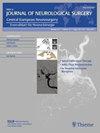在监测颅内病变时将导管置入横窦:技术说明。
IF 0.9
4区 医学
Q4 CLINICAL NEUROLOGY
Journal of neurological surgery. Part A, Central European neurosurgery
Pub Date : 2024-05-01
Epub Date: 2023-02-16
DOI:10.1055/s-0042-1759826
引用次数: 0
摘要
中风、脑外伤和脑肿瘤都可能诱发高颅内压(ICP),并导致脑损伤。监测受损大脑的血流对于检测颅内病变非常重要。与计算机断层扫描灌注成像和磁共振成像相比,血液采样是监测脑氧和血流变化的更好方法。本文介绍了如何在高 ICP 大鼠模型中从横窦采集血液样本。此外,文章还通过血气分析和神经细胞染色比较了横窦和股动脉/静脉的血液样本。这些发现可能对监测颅内病变的氧和血流具有重要意义。本文章由计算机程序翻译,如有差异,请以英文原文为准。
Placement of a Catheter into the Transverse Sinus in Monitoring Intracranial Lesions: A Technical Note.
High intracranial pressure (ICP) can be induced by stroke, brain trauma, and brain tumor, and lead to cerebral injury. Monitoring the blood flow of a damaged brain is important for detecting intracranial lesions. Blood sampling is a better way to monitor changes in brain oxygen and blood flow than computed tomography perfusion and magnetic resonance imaging. This article describes how to take blood samples from the transverse sinus in a high ICP rat model. Also, it compares the blood samples from the transverse sinus and femoral artery/vein through blood gas analysis and neuronal cell staining. The findings may be of significance to the monitoring of the oxygen and blood flow of intracranial lesions.
求助全文
通过发布文献求助,成功后即可免费获取论文全文。
去求助
来源期刊

Journal of neurological surgery. Part A, Central European neurosurgery
CLINICAL NEUROLOGY-SURGERY
CiteScore
2.30
自引率
0.00%
发文量
90
期刊介绍:
The Journal of Neurological Surgery Part A: Central European Neurosurgery (JNLS A) is a major publication from the world''s leading publisher in neurosurgery. JNLS A currently serves as the official organ of several national neurosurgery societies.
JNLS A is a peer-reviewed journal publishing original research, review articles, and technical notes covering all aspects of neurological surgery. The focus of JNLS A includes microsurgery as well as the latest minimally invasive techniques, such as stereotactic-guided surgery, endoscopy, and endovascular procedures. JNLS A covers purely neurosurgical topics.
 求助内容:
求助内容: 应助结果提醒方式:
应助结果提醒方式:


